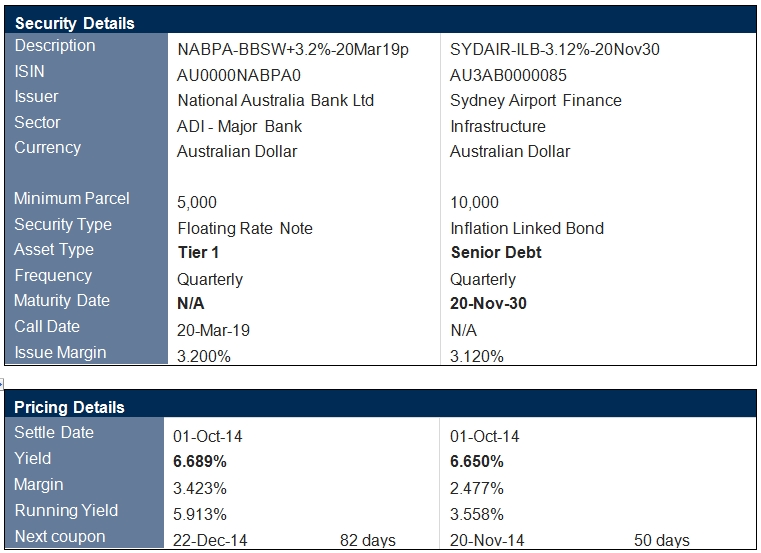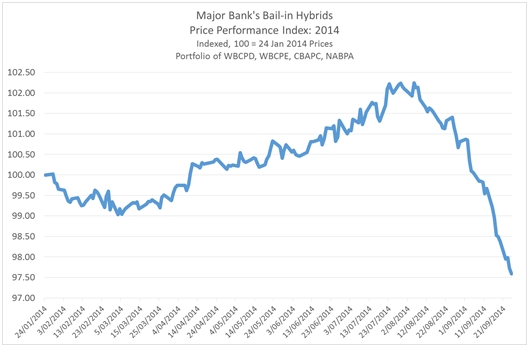by
Justin McCarthy | Sep 29, 2014
FIIG has been leading the fixed income industry’s debate about whether some of Australia’s hybrids are good value. At the core of our argument is the complexity that comes with the right of the banking regulator to convert these hybrids into equity, ie “bail-in” hybrid investors’ money, rather than have government “bail-outs”. More on this below.
But for many investors, the question is how to replace this income in their portfolio, without taking on more equity markets risk. This is particularly poignant at the moment as global equity markets seem nervous.
One area of the market that offers strong relative value at the moment is infrastructure debt. The chart below shows some examples of the infrastructure bonds our clients hold and their current relative yields. These bonds are tied to infrastructure projects of various types from education (JEM Southbank) to airports (Sydney Airport), as well as defence (Praeco) and small projects like Southern Cross Station (Civic Nexus) and the Victorian County Court Facility (JEM CCV). Each of the infrastructure bonds listed below are senior secured, placing them at the top of each issuer’s capital structure. The key point is that they all have credit ratings better than the ASX hybrids of the major banks. Even at our base assumption of CPI at 2.5%pa (mid point of the RBA target range for inflation), the infrastructure bonds are at least comparable. If you use the current CPI of 3.0%pa, almost all of the infrastructure bonds are offering better yields than the lower rated hybrids.
One important feature of these infrastructure debt securities is that their rates are linked to inflation, ie if inflation rises, their rates will rise and equally if inflation falls, their rates will fall. This is similar, but not identical, to the floating rate nature of the hybrids – their rates rise and fall with interest rates, not inflation*. Over the longer term, rates and inflation are highly correlated, meaning both will offer a similar hedge against rising interest rates relative to fixed rate bonds.
*For the technically minded, the correlation between CPI and BBSW in Australia since 1982 has been 0.86, ie very high.

Prices are accurate as at 26 September 2014
The below table compares the Sydney Airport inflation linked senior bond against the NABPA hybrid.

** Yield for Floating Rate Notes is the swap rate to Maturity / Call plus the trading margin
** Yield for Inflation Linked Bonds and Index Annuity Bonds equals Real Yield plus a current inflation assumption of 3.00%
Prices are accurate as at 26 September 2014
FIIG’s view on “bail-in hybrids”
To be clear, we do not believe that there is a large risk of one of Australia’s major banks requiring a bail out. That is not the issue here. The issue is that these “bail-in hybrids” are new structures and the market hasn’t yet figured out how to price. This will make them more volatile. Investors should be getting paid for that volatility. And we don’t believe that they are. In Europe, investors demand around 5-6 times more margin for these hybrids than they need for senior debt. CBA’s recent Perls VII offer was at just 3 times CBA’s senior debt pricing.
In fact, we don’t even consider these securities to be bonds, but instead far more like equities. History has shown us that they won’t rise as much as shares in the good times, but will fall in line with equities in the bad times. Investors are getting the worst of both worlds, and are increasingly shifting their money to either pure bonds or equities instead.
The issue here is that the complexity of these hybrids is not yet understood and therefore not being priced in. But things are changing quickly. In the past few weeks, this debate has spread to Australia from Europe, where the regulators have banned distribution of these hybrids to retail investors. Many of the bail-in hybrids have fallen sharply in price since mid-August, with several now below their issue price (as shown below).

Copyright The contents of this document are copyright. Other than under the Copyright Act 1968 (Cth), no part of it may be reproduced or distributed to a third party without FIIG’s prior written permission other than to the recipient’s accountants, tax advisors and lawyers for the purpose of the recipient obtaining advice prior to making any investment decision. FIIG asserts all of its intellectual property rights in relation to this document and reserves its rights to prosecute for breaches of those rights.
Disclaimer Certain statements contained in the information may be statements of future expectations and other forward-looking statements. These statements involve subjective judgement and analysis and may be based on third party sources and are subject to significant known and unknown uncertainties, risks and contingencies outside the control of the company which may cause actual results to vary materially from those expressed or implied by these forward looking statements. Forward-looking statements contained in the information regarding past trends or activities should not be taken as a representation that such trends or activities will continue in the future. You should not place undue reliance on forward-looking statements, which speak only as of the date of this report. Opinions expressed are present opinions only and are subject to change without further notice.
No representation or warranty is given as to the accuracy or completeness of the information contained herein. There is no obligation to update, modify or amend the information or to otherwise notify the recipient if information, opinion, projection, forward-looking statement, forecast or estimate set forth herein, changes or subsequently becomes inaccurate.
FIIG shall not have any liability, contingent or otherwise, to any user of the information or to third parties, or any responsibility whatsoever, for the correctness, quality, accuracy, timeliness, pricing, reliability, performance or completeness of the information. In no event will FIIG be liable for any special, indirect, incidental or consequential damages which may be incurred or experienced on account of the user using information even if it has been advised of the possibility of such damages.
FIIG provides general financial product advice only. As a result, this document, and any information or advice, has been provided by FIIG without taking account of your objectives, financial situation and needs. Because of this, you should, before acting on any advice from FIIG, consider the appropriateness of the advice, having regard to your objectives, financial situation and needs. If this document, or any advice, relates to the acquisition, or possible acquisition, of a particular financial product, you should obtain a product disclosure statement relating to the product and consider the statement before making any decision about whether to acquire the product. Neither FIIG, nor any of its directors, authorised representatives, employees, or agents, makes any representation or warranty as to the reliability, accuracy, or completeness, of this document or any advice. Nor do they accept any liability or responsibility arising in any way (including negligence) for errors in, or omissions from, this document or advice. Any reference to credit ratings of companies, entities or financial products must only be relied upon by a ‘wholesale client’ as that term is defined in section 761G of the Corporations Act 2001 (Cth). FIIG strongly recommends that you seek independent accounting, financial, taxation, and legal advice, tailored to your specific objectives, financial situation or needs, prior to making any investment decision. FIIG does not make a market in the securities or products that may be referred to in this document. A copy of FIIG’s current Financial Services Guide is available at www.fiig.com.au/fsg.
An investment in notes or corporate bonds should not be compared to a bank deposit. Notes and corporate bonds have a greater risk of loss of some or all of an investor’s capital when compared to bank deposits. Past performance of any product described on any communication from FIIG is not a reliable indication of future performance. Forecasts contained in this document are predictive in character and based on assumptions such as a 2.5% p.a. assumed rate of inflation, foreign exchange rates or forward interest rate curves generally available at the time and no reliance should be placed on the accuracy of any forecast information. The actual results may differ substantially from the forecasts and are subject to change without further notice. FIIG is not licensed to provide foreign exchange hedging or deal in foreign exchange contracts services. The information in this document is strictly confidential. If you are not the intended recipient of the information contained in this document, you may not disclose or use the information in any way. No liability is accepted for any unauthorised use of the information contained in this document. FIIG is the owner of the copyright material in this document unless otherwise specified.
The FIIG research analyst certifies that any views expressed in this document accurately reflect their views about the companies and financial products referred to in this document and that their remuneration is not directly or indirectly related to the views of the research analyst. This document is not available for distribution outside Australia and New Zealand and may not be passed on to any third party without the prior written consent of FIIG. FIIG, its directors and employees and related parties may have an interest in the company and any securities issued by the company and earn fees or revenue in relation to dealing in those securities.